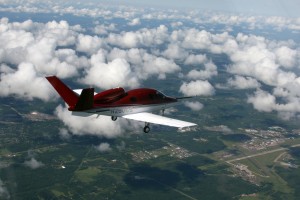
On July 3, Cirrus’ Vision SJ50 made its maiden flight. The single-engine jet took off from Duluth International Airport (DLH) in Minnesota, near Cirrus’ headquarters, for a 45-minute flight.
By Karen Di Piazza
It took Cirrus Design Corp. two and a half years to give its very light jet a name. Alan Klapmeier, chairman and CEO, said the decision to officially name its single-engine jet the Vision SJ50 was due to many reasons.
“The original thought on that name began about 12 years ago,” Klapmeier said. “We didn’t have a V-tail jet then. We think the name is more appropriate today than it ever was. This airplane is about a long-term vision that we have for changing the way people think about personal transportation aircraft.”
Klapmeier said that although the VLJ’s seat configuration can accommodate up to seven passengers, he doesn’t want people to start dubbing it as a seven-seat jet.
“I feel that’s misleading people about its capability,” he said. “It seats five adults; the two (flip-up) jump seats in the back are an extra bonus—for children or for various uses.”
Powered by a Williams International FJ33-4A-19 engine, the SJ50 made its first 45-minute flight on July 3, taking off from Duluth International Airport (DLH) in Minnesota, near Cirrus’ headquarters. On Aug. 13, Kate Dougherty, Cirrus spokesperson, confirmed that the company has received more than 500 deposits. The deposit amount is $100,000.
Klapmeier said the company would like to see the Vision reach certification in 2011.
“We hope to keep the base price at about $1 million,” he said. “We believe that the lower price will allow for higher volume. Higher volume will make it more profitable for us to keep the price lower.”
He said they haven’t set a final price because the aircraft’s systems haven’t been completed.
“There are other unknown factors, such as inflation,” he said. “When we have a final price on the Vision, we’ll announce it.”
Cirrus plans to certify the jet at a maximum flight ceiling of 25,000 feet. The company has never marketed the Vision as the next air taxi jet. However, Klapmeier pointed out that people are using the company’s four-place, single-engine piston SR22s for on-demand air charter. Greenville, S.C.-based SATSair LLC has successfully been operating a fleet of 26 SR22s as air cabs for several years.
He said he was confident that SATSair would use its VLJ in its air charter fleet. On Aug. 5, the operator officially announced its intention to do exactly that, after the SJ50 becomes certified.
Klapmeier explained why Cirrus never talked about using the Vision as a commercial FAR Part 135 air taxi aircraft.
“The Vision was designed for the owner-flown pilot, so marketing the jet as a viable air taxi option could’ve brought negative attention,” he said. “We do think that our jet will be a very good air taxi plane. You see more minivans being used for taxicabs, too, but they weren’t designed as taxicabs. We’ll make sure that Part 135 operations are in the initial certification. Cirrus’ current aircraft are certified for both Part 135 and for personal transportation purposes.”
Steve Hanvey, president and CEO of SATSair, said the SJ50 would bolster its business model by extending the scope of the company’s point-to-point air cab services beyond its traditional range. Cirrus is a 25 percent owner of SATSair.
“Cirrus’ Vision jets will enable our customers to extend the reach of their businesses in a timely, efficient manner,” he said.
Joe Leader, president of the Air Taxi Association, also believes that the Vision, as well as other planes coming into the market, will expand travel options for people.
“The SJ50 will enable SATSair to offer jet air taxi service at value-driven price points,” Leader said.
All Cirrus aircraft have whole-aircraft parachutes, which Hanvey said was another reason the SJ50 suited his air charter business. Because SATSair operates its air taxi business with a one-pilot crew, the parachute option on the Vision was a necessity.
“Our business model is based on operating single-pilot and single-engine planes at the lowest cost of operation, when utilized in a network across a given geographical area,” Hanvey said.











